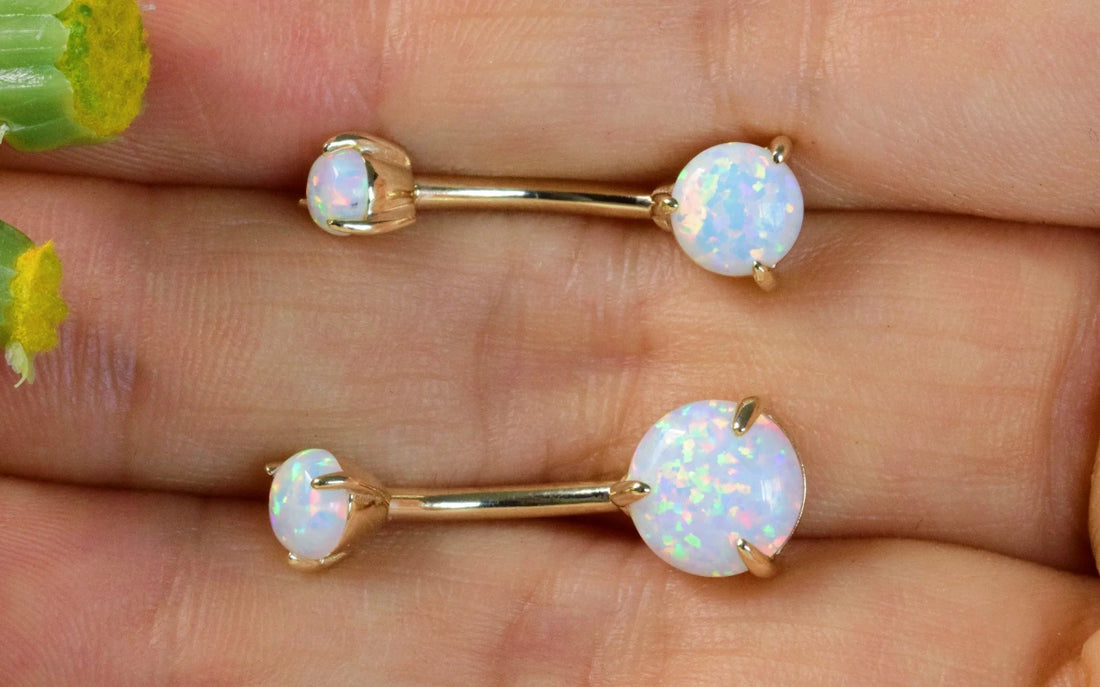
Everything You Should Know About Opal Piercing Jewelry
Share
Opal piercing jewelry has become very popular in recent years. More and more body piercing enthusiasts are finding this gem to be a perfect match for their style. This unique gem is one of the most fascinating gems, and it has a brilliant color that looks very elegant. If you want to learn about this gemstone and jewelry, this article will explain everything about opal and how to choose the right opal piercing jewelry.
What is Opal?
In simple terms, opal is a naturally occurring translucent gemstone. Unlike most other gemstones, opal is not made up of a crystal structure, and its main component is silicon dioxide. It involves the interaction of various factors: the action of water, sedimentation and temperature changes. Therefore, each naturally formed opal is unique, and their patterns and colors are different.
Opal became popular as a jewellery gemstone in Australia in the early 20th century, and Australia is still the main producer of opal, accounting for about 95% of the world's opal supply.
Synthetic Opal
Many people may not know that synthetic opals can be produced. Yes, you heard it right, and synthetic opals are usually brighter and richer in color than natural opals. The composition of synthetic opals is exactly the same as that of naturally formed opals, except that one is produced in a laboratory and the other is the result of nature and time. Both are real opals, and even synthetic opals are the most used in jewelry today. As for the reasons, there are several points:
l Synthetic opal can be mass-produced at a cheaper price, making the gem more affordable to more people.
l Because it is synthetic, variables can be controlled in the process, allowing it to have brighter colors and more vivid colors, making it look more beautiful than natural ones.
l Synthetic opals are cleaner and contain almost no impurities. Naturally occurring opals without impurities are very rare, so they are more expensive.
Opal Color
Consumers are more concerned about the price and color of opals. Opals come in many colors, including white, black, pink, flame, blue and green. Their diversity and color changes are caused by the silica microparticle structure inside them. Different structures and components will lead to different optical effects. Among them, black is the rarest and most expensive color. After all, rare things are expensive.
Black opals are usually dark grey or black in colour, and this dark background brings out the flashes of colour (i.e. ‘fire’) within them, making them visually appealing. As a result, black opals are often highly prized by jewellers and collectors. Not only are they very popular in jewellery design, especially in high-end jewellery such as rings, necklaces and various piercings, they are also investment pieces due to their rarity and collectibility. The larger the black opal, the brighter the fire and the darker the background, the higher its price.
Of course, all of the above are based on natural opal rather than artificial synthesis.
How to Choose Opal Piercing Jewelry?
When choosing opal piercing jewelry, the main thing to consider is whether to choose artificial opal or real opal. This is actually a very subjective option, which depends entirely on your personal preference. As we mentioned earlier, the purity of real opal is definitely not as good as synthetic opal. If you have requirements for purity and color, synthetic opal is more suitable for you.
In addition, if you have a limited budget, synthetic opal can save you some budget.
If you are interested in collecting some natural gemstones, it is obvious that real opals are more valuable to you.
In addition to the above factors, you should also consider the following objective factors:
When choosing opal piercing jewelry, you should also consider the metal material. Avoid materials containing nickel, which is the culprit for allergies at the piercing site. If you have sensitive skin, you should avoid it. Implant-grade stainless steel, 14k gold and titanium should be your first choice.
Decide where you want to wear it and choose the right size. Opal piercing jewelry is suitable for a variety of piercings, including ear piercings, nostrils, belly buttons, and lips. Different areas may require different shapes, sizes, and weights of jewelry. The size of the opal piercing jewelry should match the size of the piercing.
Not sure if opal styles are right for you? Here are some beautiful opal styles from gagabodys to inspire you.
How to Clean and Care for Opal Jewelry?
Whether real or synthetic opals, they are very fragile. Their Mohs hardness is only 5.5-6.0, they cannot withstand strong impacts and are easily worn, so try to avoid direct contact with other jewelry or hard objects.
Body jewelry is prone to grease and other dirt if worn for a long time. In order to keep it shiny, you need to clean it regularly. The cleaning process is also very simple. Just wipe it gently with soapy water and then rinse it with clean water. Remember not to use an ultrasonic cleaner to clean opals, which can easily cause the gemstone to break.
Opal is very sensitive to chemicals. It is composed of silica, and all chemicals that can react with silica (mainly strong acids and strong bases) must be avoided, otherwise it will cause corrosion.
Avoid excessive contact with water. Note that excessive contact here refers to prolonged immersion in water. Wearing the gemstone to swim or take a shower will not affect it. Although opal itself is a hydrous mineral, it has limited tolerance to water. Prolonged exposure to water or contact with excessive moisture may cause cracks or damage to the surface of the opal.



